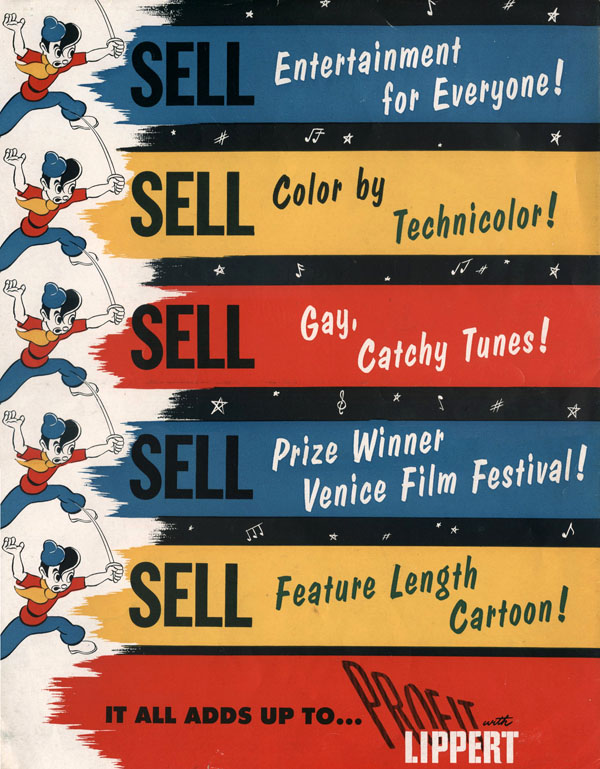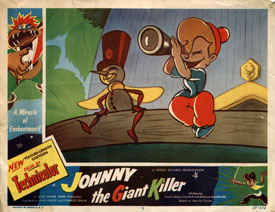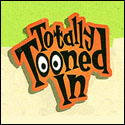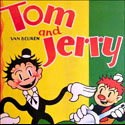Steve Stanchfield’s recent post about obscure animated features had me thinking about one of my favorite guilty pleasures – Johnny The Giant Killer. However, there is little to like about this film – the fact that it ever achieved a North American release is the true “miracle” of its production; it’s public domain status assures it’s continued existence.

JOHNNY THE GIANT KILLER (6/5/53) Lippert Pictures. 62 mins. Director and Producer: Jean Image, Charles Frank. A Jean Image Films Production. English language screenplay: Paul Colline, Charles Frank, Nesta MacDonald. Story: Eraine. Music: René Cloërec. Cinematography: Kostia Tchikine. Sound: René Sarazin. Backgrounds: Pierre Baudin, Saint-Joyerie, Amedee Tardivon, Serge Tessanech. Chief Animator: Albert Champeaux. Anmators: Denis Boutin O’Klein, Marcel Breuil, Albert Champeaux. No Voice actors credited.
STORY: A group of boys explore a castle and are captured by a giant. Johnny escapes, becomes allies with a swarm of bees, and helps the other boys escape.
Produced in 18 months with a low budget and a tiny staff, Hungarian-born cartoonist Jean Image (Imre Hajdu, 1911-89) managed to produce France’s first animated feature, Jeannot L’Intrepide (The Intrepid Jeannot) in 1950. The film went on to win the Grand Prix for children’s films at the 1951 Venice Film Festival and was eventually picked up and released in the United States (by B-movie distributor Lippert Pictures) in 1953. Re-titled Johnny the Giant Killer, it was one of the very first foreign animated features to hit the states – preceded only by Russian made The Magic Pony (1949) and Jiri Trinka’s Czech puppet feature The Emperor’s Nightingale (1951) – and one of the first non-Disney cel-animated full-length movies.
I only have three problems with this film: The character designs are poor, the animation is terrible and the storytelling is atrocious. Yet, I can’t say you won’t find this film entertaining in a Mystery Science Theatre, “so-bad-its-good” way. Nevertheless, as poor as the film is (the cheapest American cartoons of the day were far more superior to this on every technical level), it still boasts the then-novelty of Technicolor, and the musical score is quite lively.
Rene Cloeric (1911-1995), the film’s musical director, had previously written songs for Edith Piaf and scored the French classic Devil in the Flesh (1949). Doing the music for France’s first animated feature must have seemed like an honor. “In live action films, particularly dramas, music is used to highlight certain moments,” Cloeric was quoted at the time. “A dramatic picture may have as little as three minutes of music. But in animation, music runs all the way through the picture.
The film has since drifted into obscurity (as it should), save for the fact that it was never copyrighted, and is easily found for sale, lingering in cheap video bins around the world. Mark Kausler allowed me to screen his Technicolor 35mm print for Asifa-Hollywood a few years ago and it was a hoot. Here’s a clip to give you an idea of the animation quality:
Here is some of the ballyhoo Lippert Pictures was hoping to whip up during its US release – from rare pages of their press book:


Apparently the film was restored and had an anniversary re-release in France in 2010 – here is the trailer which makes it look a lot better than it is:



 Jerry Beck is a writer, animation producer, college professor and author of more than 15 books on animation history. He is a former studio exec with Nickelodeon Movies and Disney, and has written for The Hollywood Reporter and Variety. He has curated cartoons for DVD and Blu-ray compilations and has lent his expertise to dozens of bonus documentaries and audio commentaries on such. Beck is currently on the faculty of CalArts in Valencia, UCLA in Westwood and Woodbury University in Burbank – teaching animation history. More about Jerry Beck [
Jerry Beck is a writer, animation producer, college professor and author of more than 15 books on animation history. He is a former studio exec with Nickelodeon Movies and Disney, and has written for The Hollywood Reporter and Variety. He has curated cartoons for DVD and Blu-ray compilations and has lent his expertise to dozens of bonus documentaries and audio commentaries on such. Beck is currently on the faculty of CalArts in Valencia, UCLA in Westwood and Woodbury University in Burbank – teaching animation history. More about Jerry Beck [








Aarggh! I was working on a column about this. Here is as far as I had gotten.
Jeannot l’intrépede (Johnny the Giant Killer). December 13, 1950, 58 minutes.
Made by Jean Image Films, which made several short cartoons and features in the late 1940s to 1960, then adding French TV animation up until Image’s death. Johnny and a troop of boy scouts are camping in a forest. One night Johnny reads a tentful of scouts a fairy tale book about the evil giant. They sneak out to find the giant’s castle. The giant captures them all except for Johnny, whom he shrinks to insect size. A bird carries Johnny from the castle to the forest, where he sees the friendly insects of Insect-ville, saves them from a lizard, is captured by spiders, and is rescued by bees. A bee majordomo shows him how bees live. The queen bee favors Johnny, which makes the drones jealous. After Johnny defeats the head drone in a sword fight, the drone sneaks out to help the evil wasps to capture the beehive. Johnny defeats them, and the grateful queen mobilizes all the forest insects into an army to help Johnny defeat the giant and rescue the other boys. Johnny and the boys are restored to full size. The film ends with them returning to the scout camp, with the giant shrunk to insect size in a birdcage as a souvenir. Johnny the Giant Killer was the first French animation since Émile Cohl’s silent short films to be theatrically released in America, on June 5, 1953 by Lippert Pictures, usually for children’s weekend matinees.
“Made by Jean Image Films, which made several short cartoons and features in the late 1940s to 1960, then adding French TV animation up until Image’s death.”
It’s amazing how long that guy managed to stick around at all. I forgot he did this one in the late 70’s based on the bragging tales of Baron Munchhausen. Nickelodeon use to play this one a bit on Special Delivery and all I can remember was a moment of the baron underwater finally realizing he ran out of air and drowns.
https://www.youtube.com/watch?v=3NsrugYto7o
Somehow I guess the film proved popular enough for a spin-off of sorts that was made in the 80’s where the Baron and his crew sail to the moon to obtain the secret of eternal life. Entitled “The Secret of the Selenites”, it saw a US release on VHS (along with the Munchhausen film through Vestron Video) under the re-titled “Moon Madness”. The film isn’t any better than his others yet it’s got some nice music composed by Shuki Levy and one of the most bizarre ending sequences one would expect to see (it was the 80’s)…
https://www.youtube.com/watch?v=3lq7gkDSrFg
“Johnny the Giant Killer was the first French animation since Émile Cohl’s silent short films to be theatrically released in America, on June 5, 1953 by Lippert Pictures, usually for children’s weekend matinees.”
Thinking of that, if we didn’t have this film, the next one in life from France would’ve been Paul Grimault’s unfinished cinematic opus “The Curious Adventures of Mr. Wonderbird.” That’s something to think of, but Jean Image had to be the first with a feature.
I’m morbidly fascinated by the idea the American release is a couple reels shorter than the original. What was there that failed to match the quality of what we DID see?
Would like to think it was hot stuff about Jack’s weird romance with the queen bee (“Oh, Queenie!”). But suspect it was more of the lame “bug town” only glimpsed in the American cut.
I do remember seeing it on TV in the early 60s, or at least the climax where the giant puts the boys in a sandwich. Thinking it was cut up into a serial for a kiddie show.
I just watched the clip and boy, it sure is awful! Jerry, I saw that you gave this movie 0 stars in your book “The Animated Movie Guide.”
1950?
Johnny looks like he’s from 1935 Iwerks, and the giant looks like he’s from 1975 Cruikshank.
Weird.
This film might be obscure in the U.S. – not so much in its home country France! Here’s a fully restored Blu-ray/DVD edition with special features such as a 20-page booklet and a documentary portrait of the director Jean Image: http://www.amazon.fr/Jeannot-lintrepide-Combo-DVD-Blu-ray/dp/B0040MF2L6/ref=sr_1_1?ie=UTF8&qid=1396280771&sr=8-1&keywords=Jeannot+l%27intr%C3%A9pide
Anyway, thanks for the post, Jerry (even if most of it is the same as your review in the excellent “The Animated Movie Guide” book). I might just have to check this out. It’s historically interesting AND it seems incredibly weird… that’s certainly enough to pique my curiosity. 😉
I do remember reading about this film in “The Animated Movie Guide”. Man, for some reason, parts of the first clip actually made me think of those cheesy animated cutscenes in the notorious Zelda CDI games. Some of the animation in the second clip didn’t look all that bad, though.
Also, what Rene Cloeric said about music for animation is absolute baloney.
Hoping that some firebrand will claim “Pixar ripped off A Bug’s Life from this!” Glad to see Alameda’s own ozone-tycoon Bob Lippert got it here….
In the TV serialized version of “Jeannot L’Intrepide” entitled “Johnny and the Giant”, a lot of the footage that Lippert cut was used in black and white. I remember a lot of the cut scenes were at the beginning, as the scouts told each other spooky stories around the campfire, and there were a lot more scenes of suspense as the boys first invaded the Giant’s castle. The serialized version was a part of the “Captain Sailorbird” series, I think it was released by Radio and Television Film Packagers in the 1950s. If you’ve ever seen one of the earliest Mexican cartoons in color, called “Las Abejas” (The Bees), a lot of the staging and layout design of the bee hive interiors used in the Mexican cartoon was appropriated by Jean Image for use in his feature.
Shocked this isn’t a Thunderbean Thursday post!
Mark K.: I think I’ve seen “The Bees”…was it part of the Flamingo package? I know I had something like that in 16mm and it really reminded me of the bee hive sequences in this film.
Steve Stanch: Have the Kid Pics VHS of Johnny? This, as a thrift store find some 15 years ago, was a lovely (and very Tommy Stathes-ish) introduction to the film for me.
For some reason, that film plot about a boy visting a hive of bees reminds of Disney planning to do something like this with Mickey around the same time (or was in the early to mid-fortie? I’m trying to remember if Walt Kelly did the layout for that as I still don’t have a copy of “The Disney That Never Was”.) I wonder if they abandoned that Mickey vehicle because of this weak film.
This looks like something that Screen Gems would make back in the 1940s. (Not to insult Fox & Crow and Cockatoos for Two.)
Interesting that one of the correspondents above should bring up “Mr. Wonderbird”, while another should have memories that this was cut up into a serial for television.
Back around 1963, KTLA (Channel 5 here in Los Angeles), had a package of serialized animated tales, which they usually used for a Sunday morning show that wound up with whatever they had that they didn’t think good enough for weekday presentation. These included “The Shepherdess And The Chimney Sweep”, which was our old pal “Mr. Wonderbird” cut up into “x” number of chapters. Another tale used was Andersen’s “The Tinder Box”.
Each “chapter” would end with a white question mark slwly advancing from center of screen, while a narrator gave out with the “what-will-happen-next?” spiel.
Problem with these was that the chapters were not numbered, nor was there any real indication as to beginning. (This was the same problem I noticed at the time with KHJ (9)’s running of “Herge’s Adventures of Tintin”.)
Apparently, this format was fairly popular, and the stations that ran it cold get the material cheaply. That–and the fact that they were in color–may explain why they ran, at various times, through the middle 1960’s.
I seem to remember reading that there were stories with a “space exploration” theme, but I don’t remember seeing these.
So they ran these things out of order? That must be a total tease for anyone trying to follow along.
At least they managed to get a little mileage out of it thanks to being in color.
The “space exporation” thing you’re thinking of is probably this production from Fred Ladd:
http://en.wikipedia.org/wiki/The_Space_Explorers
I remember Flippo the Clown showing both the first series and its sequel on Columbus, Ohio TV, and even as a kid I noticed an awful lot of padding to make a serial out of fairly short films. Like “What Has Gone Before” recaps that were longer than the day’s current episode…
One of the Thunderbean DVDs had a selection of clips from the serial “Mr.E”, with entertaining commentary. That one took a Russian short about a friendly little alien coming to Earth to learn about mankind and threw in assorted unrelated animation that was supposed to represent what he was being told.
I’d really like to see that one in its entirety. Or some of the other serials, in their TV or original form. They even used a Karel Zeman feature about kids meeting dinosaurs, which had been adapted for American release with neatly matched footage of American kids.
A curio on the early Disney Channel was titled, I think, “Ludwig’s Think Tank.” It was pretty much the same idea, redubbing old Von Drake animation to link short films mainly made for classroom use.
There is more info on the “Capt’n Sailorbird” show on Ron Kurer’s Toon Tracker website, including a text that this writer did on the release of “Johnny the Giant Killer” (called there “Johnny Little and the Giant”) on that show: http://archive.is/G8mDE
James E. Parten: The “Tinder Box” serial that you saw on “Capt’n Sailorbird” might be the Danish feature “Fyrtojet” (1946), which was based on that same Andersen tale and was Denmark’s first animated feature.
Only thing was–it wasn’t “Captain Sailorbird” in this market.
These cartoons were simply dropped into a Sunday-morning show hosted by Skipper Frank (Herman), sandwiched in among some semi-educational features. (I remember one show where the guest showed off a cylinder phonograph.)
Perhaps a little later, these were pt into an early- to mid-morning (ca. 8:30) show that had run various of the Mel-O-Toons–some of which had an adenoidal, nasal-voice announcer placed over the “The End” card, telling us that this cartoon had been selected for viewing by our armed forces overseas. (That would be worse than permanent K.P. duty!)
I had no way of knowing if they were run out of order or what.
“Jeannot” has enough color, dash, and imagination to make up for its ‘technical’ flaws. I’d encourage anyone to seek out Carlotta’s stunning restoration before making any snap judgments.
And the additional footage is terrific.
The series that had the “selected for Armed Forces Television” ending was Bozo’s Cartoon Storybook; syndicated by Larry Harmon and Jayark Films. They all had intros by Bozo (if I recall correctly, riding a miniature train.) I have distant memories of a Mexican (or Spanish) cartoon based on the song “La Cucaracha,” which may have been in this package. Anybody know??
When discussing sub-par foreign features, one should not forget GARBANCITO DE LA MANCHA (USA: THE ENCHANTED SWORD), a 1945 fairy tale from Spain directed by José María Blay and Arturo Moreno.This was popular enough for a sequel, HAPPY VACATIONS, to be rushed through. It attempted some FANTASIA-like sequences, and was a total disaster. (They’ve both been out on VHS for the Spanish-speaking market.) Here’s a clip from the initial film: http://youtu.be/eb0X6egO4c4
GARBANCITO’S opening: http://youtu.be/V1gzjraR_zw
Went over to ToonTracker and saw the title care for those “Storyland” cartoons. I don’t remember them being connected with Bozo, but the image looks familiar. KTLA (5) ran these in that eight-thirty a.m.slot that also had run such things as the serialized “Tinder Box”.
It’s surprisng what gets stuck in the old memory, isn’t it?
Here in Spain, GARBANCITO (which means in Spanish “little chick pea” or “little garbanzo bean”) is hailed as a classic, Whathever its flaws, it scores points because it was made by a team with virtually no previous experience in animation (except director Arturo Moreno, who had been making animated shorts since the late 20’s) and one of the very first European animated features to be produced in color (in Dufaycolor, a British-made process; film was sent to London for color processing while this city was being bombed by the Nazis) and because it was made during the darkest years of Franco’s dictatorship, while Spain was trying to recover from its then-recent Civil War. Jerry, if you want, I can volunteer to write a longer piece on this movie.
I may take you up on that Alfons!
In the early 1950s, as a small boy, I was taken to see a ‘full length’ cartoon film on show in the Liverpool area which I really enjoyed and was called something like ‘Johnny Lionheart ‘ or ‘Johnny the Lionheart’. Is this the same film as Johnny the Giant Killer ? Thank you.